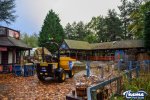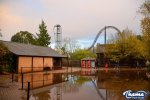Alright, I'll give it a go. I'm no planner or civil engineer, but sit through lots of meetings about things like this.
Full application (standard time limit) – This one is fairly self-explanatory. Puts an end date to the planning permission if no progress has been made. This is a coverall clause you see nationally preventing spurious planning applications.
List of approved plans – Again, fairly obvious. Loosely, you’ve got to build what you said you would.
Construction Environmental Management Plan (CEMP) – This is basically requiring that the development will be constructed in line with the environmental impact management plan that has been drawn up. In my experience these documents are submitted during planning, and then amended/revised/etc as the development goes on providing more granular detail for each of the respective elements.
Tree protection – Sort of the same as the CEMP, above. But for trees.
Scheme of implementation – This requirement is to ensure the development programme is communicated to the council. It will mean the planners and contractors will have to submit details of project phasing, timelines, milestones, etc – and it sounds like they’re particularly interested in the flood risk/biodiversity stuff (which is understandable as this was one of the main sticking points for the project – on others I’ve done it’s noise/light pollution, piling works, etc). This document likely doesn’t exist in any meaningful form at the moment, but as the engineering design is developed and the contractors are engaged, this will be drawn up and shared/commented. It’s unlikely there would be anything in this document that would delay the project inherently, it’s more likely to just have some questions or adjustments as time goes on. Again, in my experience, this sort of document(s) tend to be constantly evolved along the way, and are only shared with the council at key project milestones, but that’s not to say it might not be slightly different for this council – never done a project in this area.
Site Waste Management Plan – Again this is bread and butter for a contractor. Will set out how waste will be managed from the site.
Surface water control – SuDS (
Sustainable
Drainage
Systems) relate to providing surface water drainage designs that don’t rely on just connecting up to the nearest storm water drain. Think attenuation ponds or soakaways (to my not-civil-engineer brain), or even things like rainwater harvesting systems. I don’t know all the nitty gritty, but the crux is that there are ways to calculate what can and can’t be discharge into the storm drains (this is usually a peak daily flowrate). They’re going to have to update their SuDS strategy document based on ground testing, further design, etc. I expect this is just part of the engineer’s/contractor’s design development as they work out all the details.
Contaminated Land – In short: Assess the land, assess the extent of contamination, plan the remediation, execute the remediation, report it all. I bet there’s more to it than that, but I’m a mechanical engineer so it’s all just mud to me.
Landscaping – Landscaping design needs to be submitted. This is generally wrapped up with a lot of the drainage and SuDS stuff, but is usually just part of the standard design development.
Landscape and Ecological Management Plan – Basically, see CEMP, above.
Programme of archaeological work – They want a plan for this. In itself it’s not a major topic, but if they were to find something it can be a maaaajor headache. Impossible to tell with this one (especially as I don’t have a clue about the history of local area, and therefore the likelihood).
External materials (details required) – They just want to see details. This stuff will be developed during the design, and I doubt would be an issue.
SuDS (verification) – See the Surface Water bit above.
Flood compensation – Kiiiinda the same as the SuDS stuff. Just needs the design documentation submitting.
So, there’s nothing here that isn’t already probably on the designers’ radars. None are likely to cause any major issues, but it’s hard to say without knowing what they’ll find in the ground or what they might run up against as part of the design process. In general, I don't think any of these things will be insurmountable, but don't hold me to that.

[/B][/U]





